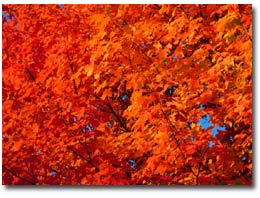Consider Fall Leaf Color When Choosing Your Next Plantings
NABBW’s Gardening Associate
 Close your eyes and imagine a bed of tulips – translucent reds, saturated yellows, crayon bright oranges. Imagine the sun shining through these tulips, making them appear as colored lights. Imagine these tulips 40, 50, 100 feet tall, a woods of tulips lining the road and you’re in a car driving through them on a beautiful, clear autumn day.
Close your eyes and imagine a bed of tulips – translucent reds, saturated yellows, crayon bright oranges. Imagine the sun shining through these tulips, making them appear as colored lights. Imagine these tulips 40, 50, 100 feet tall, a woods of tulips lining the road and you’re in a car driving through them on a beautiful, clear autumn day.
What you’re driving through is an Eastern forest of oak and maple, ash and beech, tulip poplars and sycamores in the fall.
Fall leaves are like that – petals in a giant garden. If you have the fortune to live in a part of the country that experiences autumn leaves, count yourself among the lucky ones. I love living in a place with four seasons. To me this is among the richest of all gardening experiences. When I visit Arizona, I meet transplanted Midwesterners who consider themselves clever for having fled the raking of leaves and the shoveling of snow and for having discovered the beauty of the desert and the warmer temperatures. I appreciate that beauty as well, but only for visits. If my husband ever wants to move south, he’ll have to drag me, kicking and screaming.
When gardeners neglect to consider fall leaf color in planning their gardens, they miss out on one of its greatest dimensions. But if you plan for it, you can enjoy a season of color unrivaled in any tropical garden. Think of foliage color the same way you think of flower color.
Leaves start winding down as nights grow longer and cooler.
Perhaps their descent into death is a message to the rest of us — don’t go quietly! Three families of chemicals cause leaf pigmentation: chlorophyll, which makes leaves green, reacts with sunlight to manufacture sugars for food; carotenoids produce yellow, orange and brown colors, as in daffodils and buttercups, but also carrots and bananas; and anthocyanins, the reds, tint cherries, apples, strawberries, as well as roses. Leaves produce chlorophyll throughout the growing season but as nights grow longer, production slows, and finally stops, revealing the underlying yellow carotenoids. Colors vary from year to year, but because carotenoids are always present in leaves, yellow and gold colors appear reliably.
But red color is much more dependent on weather Leaves produce anthocyanins in reaction to bright light and extra plant sugars in the leaf cells during the fall, so on sunny, warm days, they produce a lot of sugar. On cool nights with temperatures above freezing, the leaf veins close up, locking the sugars in. Such weather produces the most brilliant fall days when the red, purple, and crimson anthocyanin pigments appear. And the anthocyaninins often combine with the carotenoids\’ colors to create the deeper orange, fiery reds, and bronzes typical of many hardwood species.
Autumns are like snowflakes – no two are ever exactly the same.
Some falls are disappointing, and the reds just never seem to show up. And others – like this year, actually – are spectacular. Besides the amount of sunshine, temperature and moisture in the air and moisture in the soil also influence the show.
Each plant species has its particular chemical makeup, and you can count its their leaves turning a certain color. Some tree and shrub cultivars are bred for fall color.
Besides being genetically disposed to show different colors, different species also change their color at different times. Sourwoods are among the earliest and can change sometimes as early as late summer, while oak leaves often remain green even after other trees have shed all their leaves, until they finally give up.
When you consider the color of leaves as well as flowers, you’ll appreciate more of the richness of nature outside your window, and begin to enjoy a much longer season of a garden that’s an ever-changing tapestry.
Here are some suggestions – though not an exhaustive list – of deciduous plants that give a pretty good fall show. Many of these grow throughout the United States. Check your local nursery to find out if they grow well in your area.
Reds, purples, red-oranges:
- Trees: maple, cherry, dogwood, oak, parrotia, persimmon, sourwood, tupelo, ginkgo, crape myrtle, serviceberry
- Shrubs: chokecherry, oakleaf hydrangea, stephanandra, viburnum plicatum, blueberry, cutleaf sumac
- Perennials: hardy begonia, epimedium, euonymous, sedum \’Dragon\’s Blood\’, leadwort (Ceratostigma), bergenias, foamflowers (Tiarella), and foamy bells (Heucherella), flame grass (Miscanthus purpurascens)
Yellows, golds, yellow-oranges
- Trees: yellowwood , horse chestnut, Chinese elm, sweet gum, some maples
- Shrubs: clethra, fothergilla, kerria, viburnums, spireas
- Perennials: bluestars (Amsonia), daylilies (hemerocallis), hosta, coneflowers (Echinacea), Siberian iris, Sedum brilliant, Solomon\’s seal (Polygonatum), Japanese silver grass (Miscanthus sinensis), fountain grasses (Pennisetum alopecuroides \’Cassian\’ and \’Hameln\’)
Deborah Clark says she might never have taken up gardening if she hadn’t had neighbors who shared their love of gardening with her – but moved away.
It all started in 1973, she says, when a departing neighbor invited her to take care of an already-planted community vegetable garden plot: all she had to do was weed and harvest. She was hooked.


Leave a Reply
You must be logged in to post a comment.